
Roy Fox Lichtenstein was an American pop artist. During the 1960's, along with Andy Warhol, Jasper Johns, and James Rosenquist, he became a leading figure in the new art movement. His work defined the premise of pop art through parody. Inspired by the comic strip, Lichtenstein produced precise compositions that documented while they parodied, often in a tongue-in-cheek manner. His work was influenced by popular advertising and the comic book style. His artwork was considered to be "disruptive". Lichtenstein described pop art as "not 'American' painting but actually industrial painting". His paintings were exhibited at the Leo Castelli Gallery in New York City.

Russell Heath Jr. was an American artist best known for his comic book work, particularly his DC Comics war stories and his 1960s art for Playboy magazine's "Little Annie Fanny" feature. He also produced commercial art, two pieces of which, depicting Roman and Revolutionary War battle scenes for toy soldier sets, became familiar pieces of Americana after gracing the back covers of countless comic books from the early 1960s to early 1970s.

Whaam! is a 1963 diptych painting by the American artist Roy Lichtenstein. It is one of the best-known works of pop art, and among Lichtenstein's most important paintings. Whaam! was first exhibited at the Leo Castelli Gallery in New York City in 1963, and purchased by the Tate Gallery, London, in 1966. It has been on permanent display at Tate Modern since 2006.

Men of War is the name of several American comic book series published by DC Comics. For the most part, the series was a war comics anthology featuring fictional stories about the American military during World War II.
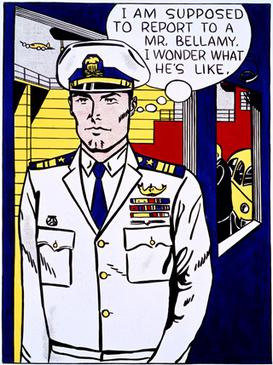
Mr. Bellamy is a 1961 pop art painting by Roy Lichtenstein in his comic book style of using Ben-Day dots and a text balloon. The work is regarded as one of the better examples of Lichtenstein's sense of humor. The work is held in the collection at the Modern Art Museum of Fort Worth.

Torpedo...Los! is a 1963 pop art oil on canvas painting by Roy Lichtenstein. When it was last sold in 1989, The New York Times described the work as "a comic-strip image of sea warfare". It formerly held the record for the highest auction price for a Lichtenstein work. Its 1989 sale helped finance the construction of the current home of the Museum of Contemporary Art, Chicago in 1991.

Look Mickey is a 1961 oil on canvas painting by Roy Lichtenstein. Widely regarded as the bridge between his abstract expressionism and pop art works, it is notable for its ironic humor and aesthetic value as well as being the first example of the artist's employment of Ben-Day dots, speech balloons and comic imagery as a source for a painting. The painting was bequeathed to the Washington, D.C., National Gallery of Art upon Lichtenstein's death.
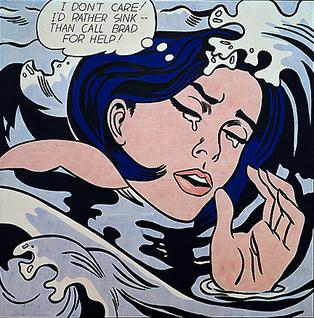
Drowning Girl is a 1963 American painting in oil and synthetic polymer paint on canvas by Roy Lichtenstein, based on original art by Tony Abruzzo. The painting is considered among Lichtenstein's most significant works, perhaps on a par with his acclaimed 1963 diptych Whaam!. One of the most representative paintings of the pop art movement, Drowning Girl was acquired by the Museum of Modern Art in 1971.
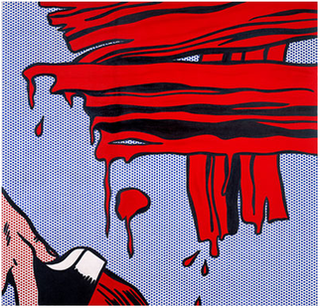
Brushstrokes series is the name for a series of paintings produced in 1965-1966 by Roy Lichtenstein. It also refers to derivative sculptural representations of these paintings that were first made in the 1980s. In the series, the theme is art as a subject, but rather than reproduce masterpieces as he had starting in 1962, Lichtenstein depicted the gestural expressions of the painting brushstroke itself. The works in this series are linked to those produced by artists who use the gestural painting style of abstract expressionism made famous by Jackson Pollock, but differ from them due to their mechanically produced appearance. The series is considered a satire or parody of gestural painting by both Lichtenstein and his critics. After 1966, Lichtenstein incorporated this series into later motifs and themes of his work.

Blam is a 1962 painting by Roy Lichtenstein falling within the pop art idiom. It is one of his military comic book derivatives and was one of the works presented at his first solo exhibition. The work is in the collection at the Yale University Art Gallery

Engagement Ring is a 1961 pop art painting by Roy Lichtenstein. The work is based on the Winnie Winkle series, but Lichtenstein changed both the graphical description and the narrative accompaniment that he presents in a speech balloon. As with most of his early romance comics works, this consisted of "a boy and a girl connected by romantic dialogue and action".
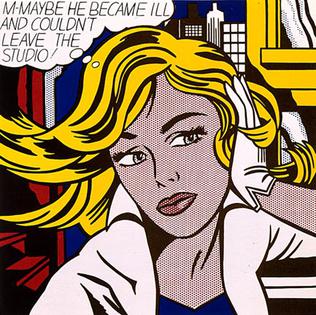
M-Maybe is a 1965 pop art painting by Roy Lichtenstein. It is one of his romance comics-based works.

Crying Girl is the name of two different works by Roy Lichtenstein: a 1963 offset lithograph on lightweight, off-white wove paper and a 1964 porcelain enamel on steel.

Hopeless is a 1963 painting with oil paint and acrylic paint on canvas by Roy Lichtenstein. The painting is in the collection of the Kunstmuseum Basel.
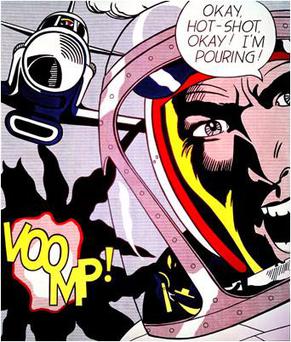
Okay Hot-Shot, Okay! is a 1963 pop art painting by Roy Lichtenstein that uses his Ben-Day dots style and a text balloon. It is one of several examples of military art that Lichtenstein created between 1962 and 1964, including several with aeronautical themes like this one. It was inspired by panels from four different comic books that provide the sources for the plane, the pilot, the text balloon and the graphic onomatopoeia, "VOOMP!".

Bratatat! is a 1963 pop art painting by Roy Lichtenstein in his comic book style of using Ben-Day dots and a text balloon.

Brattata is a 1962 pop art painting by Roy Lichtenstein in his comic book style of using Ben-Day dots and a text balloon. The work is held in the collection at the Tehran Museum of Contemporary Art. It is one of several Lichtenstein works from All-American Men of War issue #89, but is a reworking of its source panel.

Varoom! is a 1963 pop art painting by Roy Lichtenstein that depicts an explosion and the onomatopoeic sound that gives it its name.

Takka Takka is a 1962 pop art painting by Roy Lichtenstein in his comic book style of using Ben-Day dots and a story panel. This work is held in the collection of the Museum Ludwig. The title comes from the onomatopoeic graphics that depict the sound that comes from a machine gun.

Crak! is a 1963 pop art lithograph by Roy Lichtenstein in his comic book style of using Ben-Day dots and a text balloon. It was used in marketing materials for one of Lichtenstein's early shows. It is one of several of his works related to military art and monocular vision.





















